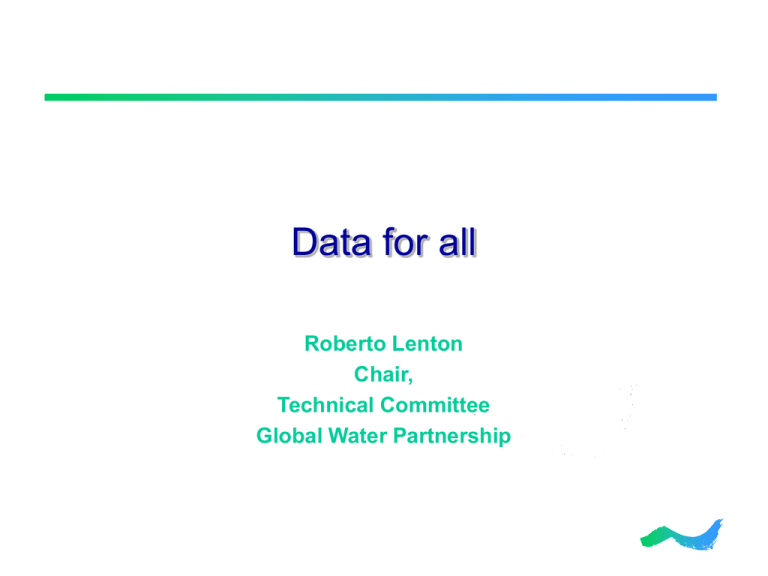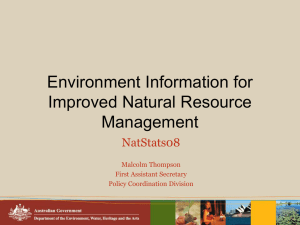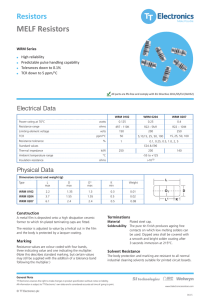Data for all Roberto Lenton Chair, Technical Committee
advertisement

Data for all Roberto Lenton Chair, Technical Committee Global Water Partnership Outline (mirrors the issues to be discussed) Context and inherent challenges Data needs and acquisition – demand and supply issues Data integration and dissemination: from data to information, institutional and methodological barriers Best practices, actions needed and issues for the future Context and inherent challenges Global Water Partnership Data <-> Water resources management <-> Development Goal 1: Eradicate extreme poverty and hunger Goal 2: Achieve universal primary education Goal 3: Promote gender equality and empower women Goal 4: Reduce child mortality Goal 5: Improve maternal health Goal 6: Combat HIV/AIDS, malaria and other diseases Goal 7: Ensure environmental sustainability Target 9: Integrate the principles of sustainable development into country policies and programmes and reverse the loss of environmental resources Target 10: Halve, by 2015, the proportion of people without sustainable access to safe drinking water and basic sanitation Target 11: By 2020, to have achieved a significant improvement in the lives of at least 100 million slum dwellers Goal 8: Develop a global partnership for development Background and Context Data for what? Goal-driven “data demand” data for water resources management water resource management for development Data, water and development nexus – across all water use sectors Need attention to both water resources availability (supply) and requirements (demand) – and the relationship between the two Need attention to both data production (supply) and data use (demand) – and the relationship between the two Both data supply and data demand involve multiple sectors and actors (e.g., agriculture, climate) Integrated approach needed – so comprehensive “data for all” topic of the Forum is much welcomed! But we are far from having solid analytical frameworks and institutional mechanisms for WRM data Access to Water Supply and Sanitation – a workable model: Agreed conceptual framework for defining and measuring access Established Institutional Mechanism: Joint Monitoring Programme of UNICEF/WHO Water resources management: No agreed conceptual framework as yet Emerging Institutional Mechanism: the World Water Assessment Programme and the WWDRs Why makes data for water resources management so challenging? 1. 2. 3. 4. 5. 6. Water resources management is a means towards broader goals – need to understand and quantify relationship between ends and means Interactions among different elements of water resources management and use often poorly understood Data needs have multiple dimensions – quantity, quality, temporal, spatial… Climate change introducing new complexities – and more urgent needs Multiple sectors and professions involved in water data supply and demand Role of some key actors insufficiently recognized – e.g. statistics, climate science – and perhaps viewed with some suspicion Integrated Water Resources Management provides an overall basis Basic principles: water as social and economic good, holistic perspective, involvement of stakeholders Balancing economic efficiency, environmental sustainability, social equity Aligning interests and activities that are traditionally seen as unrelated or not well coordinated (horizontally and vertically) Not just water -- integrating water in overall sustainable development processes Data needs and Acquisition – Demand and Supply Issues Global Water Partnership Data needs -- domains WWAP Expert Group on Indicators identified four “domains” of data: The state of the resource (e.g., total actual renewable water resource, at different time frames) The use of the resource (e.g., agriculture water use) The governance of the resource (e.g., quality of water resource management) The performance of the resource (e.g., proportion of urban wastewater that is treated) Data needs Simplicity of four domains masks huge challenges - Most parameters are multi-dimensional – quantity, quality, spatial and temporal variation Different methodologies needed, especially viz. a viz. governance No agreed set of indicators in each domain – identifying them is a key priority of the Expert Group Interactions among domains -- different elements of water resources management and use -- poorly understood Climate change introduces “non-stationarity” considerations Data acquisition Data acquisition is often viewed as un-interesting in comparison with performance indicators – but it needs to get at least the same level of attention 3rd WWDR: Highlights that new data are hard to come by. Available for only a few indicators Current state of affairs is hampering insights into the trends of key indicators in a rapidly changing world – e.g., is water use efficiency improving? Don’t want availability to drive indicator selection, but need to concentrate on indicators for which data is readily available Data integration and dissemination: from data to information institutional and methodological barriers Global Water Partnership Methodological challenges -- what is needed to turn data into information useful for WRM? Decision makers need to measure the ultimate economic, social and environmental impact of WRM changes -- “outcome” indicators” Requires a conceptual framework to link WRM to national development goals -- and analytical systems to define and measure them Just as GDP – the key indicator of national economic performance – is derived from the system of national economic accounts, so must the indicators of “water” performance be based on a system of water accounts What are the implications? Need a framework that: is quantitative and comprehensive with respect to the use and management of water in a national economy allows analysis and quantification of inter-linkages integrates water with other natural resources and with economic, environmental and social impacts provides consistent and transparent frame of information for stakeholders Institutional barriers Different communities of data suppliers, with different languages -- and often mutual suspicion Different communities of users, with different languages -- and often mutual suspicion Little involvement of data management specialists -- the statistics community No agreed institutional framework similar to the JMP in water supply and sanitation Best practices Actions needed Issues for the future Global Water Partnership Examples of best practices for data collection and management Joint Monitoring Programme (JMP) System of Environmental and Economic Accounting (SEEA 2003) under the aegis of the UN’s Statistical Commission Regional Climate Outlook Forums Examples of best practices for data collection and management – the JMP Joint effort within the UN system Agreed methodology of measuring access to water and sanitation Based on survey methodologies Numbers enormously influential The System of Environmental-Economic Accounting for Water (SEEAW) Part of a broader movement towards environmental accounting Based on the System of Environmental and Economic Accounting (SEEA 2003) under the aegis of the UN’s Statistical Commission Accounting system includes both physical and monetary accounts The physical accounts for water quantify the volume of water assets, water use and supply by sector, and water emissions by sector The monetary accounts quantify the value of water assets, the cost of supplying water, the tariffs paid for water and emissions, and the economic value of water and pollution. Authority: based on established system of national accounts, with expertise from the statistical community, and testing in several countries Important methodological challenges – e.g., spatial and temporal variation Regional Climate Outlook Forums Participants: National Meteorological Services, international climate modelers and researchers, sectoral user groups (food security, water, health), social scientists and sectoral researchers, private sector, civil society, donors Products: Authoritative consensus on the likely quality of main rainfall seasons regularly available in advance Increased capacity at regional and national levels for climate forecast production and use Vigorous dialogue among climate forecasters and between forecasters and forecast users to improve forum products and outcomes Emergence of regional climate information and applications networks as focal points for seasonal forecasting-related activities. Important Ongoing Data-related Initiatives United Nations World Water Development Report World Water Assessment Programme Expert Group on Indicators, Monitoring and Data/Metadata bases UN-Water Task Force on Indicators, Monitoring and Reporting UN Statistics Division work on SEEA-Water (further development and use at the country level) Secretary General’s Advisory Board on Water and Sanitation Need mechanism for learning from best practices and for interaction among initiatives Can we engage with and learn more from current best practices? Need mechanism for learning, interaction among initiatives Involve user countries in a central way Involve key actors, both users and producers Include members of water, statistical and climate communities Bring in additional social, economic and environmental expertise as needed Perhaps a periodic “roundtable forum on water data”? Challenges for the “Data for all” Sessions Sessions provide a real opportunity to tackle the multiple dimensions of the data issue in a comprehensive way Address methodological issues -- links between data domains, multiple dimensions, etc. Address institutional issues Engage multiple sectors and professions involved in water data supply and demand – especially statistics and climate communities Foster a stronger “data and information culture” in water resource management Thank you www.globalwaterforum.org


